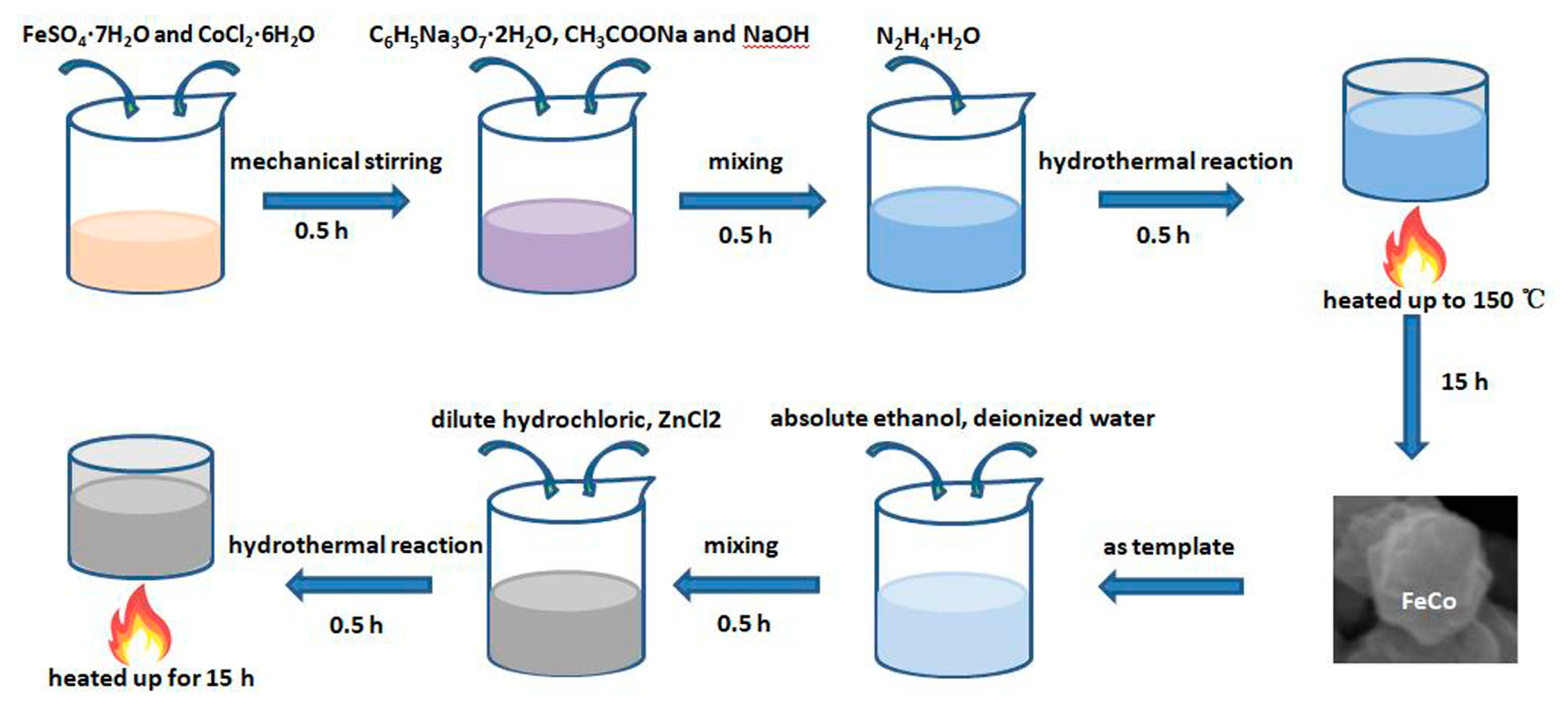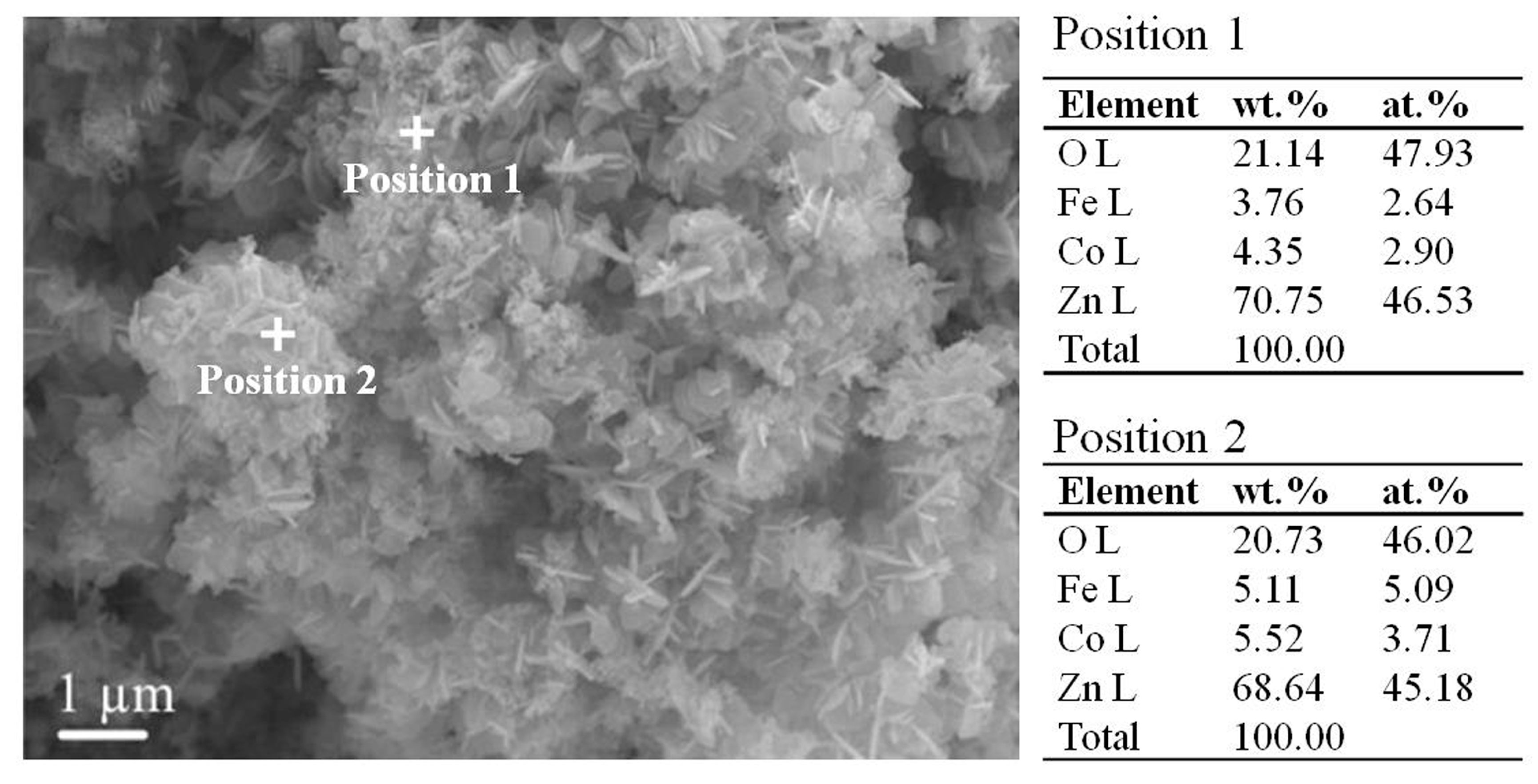The Preparation of FeCo/ZnO Composites and Enhancement of Microwave Absorbing Property by Two-Step Method
Abstract
:1. Introduction
2. Experimental Procedures
2.1. Preparation of FeCo Single-Phase Solid Solution
2.2. Preparation of FeCo/ZnO Composites
2.3. Characterization
3. Results and Discussions
3.1. Microstructure and Microwave Absorption Property Characterization of FeCo Single-Phase Solid Solution
3.2. Microstructure and Microwave Absorption Property Characterization of FeCo/ZnO Composites
3.3. Microstructure and Microwave Absorption Properties of FeCo/ZnO Composites at Different Temperatures
4. Conclusions
Author Contributions
Funding
Conflicts of Interest
References
- Dang, B.; Chen, Y.; Shen, X.; Chen, B.; Sun, Q.; Jin, C. Fabrication of a nano-ZnO/polyethylene/wood-fiber composite with enhanced microwave absorption and photocatalytic activity via a facile hot-press method. Materials 2017, 10, 1267. [Google Scholar] [CrossRef] [PubMed]
- He, G.; Huang, B.; Lin, Z.; Yang, W.; He, Q.; Li, L. Morphology transition of ZnO nanorod arrays synthesized by a two-step aqueous solution method. Crystals 2018, 8, 152. [Google Scholar] [CrossRef]
- Adeela, N.; Usman, K.; Munawar, I.; Maaz, K.; Khalid, J.; Saira, R.; Shahzad, N.; Han, X.F. Temperature-Dependent Magnetic Response of Antiferromagnetic Doping in Cobalt Ferrite Nanostructures. Nanomaterials 2016, 6, 73. [Google Scholar] [Green Version]
- Ding, Y.; Zhang, L.; Liao, Q.L.; Zhang, G.J.; Liu, S.; Zhang, Y. Electromagnetic wave absorption in reduced graphene oxide functionalized with Fe3O4/Fe nanorings. Nano Res. 2016, 9, 2018–2025. [Google Scholar] [CrossRef]
- Huang, Y.M.; Peng, Y.J.; Jiang, W.; Wang, T.X.; Jin, H.Y.; Leng, S.P.; Wang, G.A. Matched loads using substrate integrated waveguide and shaped absorbing material for KA-/Q-band applications. Microw. Opt. Tech. Lett. 2017, 59, 1174–1178. [Google Scholar] [CrossRef]
- Xu, P.; Han, X.J.; Jiang, J.J.; Wang, X.H.; Li, X.D.; Wen, A.H. Synthesis and Characterization of Novel Coralloid Polyaniline/BaFe12O19 Nanocomposites. J. Phys. Chem. C 2007, 111, 12603–12608. [Google Scholar] [CrossRef]
- Zhao, B.; Fan, B.B.; Shao, G.; Wang, B.B.; Pian, X.X.; Li, W.; Zhang, R. Investigation on the electromagnetic wave absorption properties of Ni chains synthesized by a facile solvothermal method. Appl. Surf. Sci. 2014, 307, 293–300. [Google Scholar] [CrossRef]
- Shen, G.Z.; Xu, M.; Xu, Z. Double-layer microwave absorber based on ferrite and short carbon fiber composites. Mater. Chem. Phys. 2007, 105, 268–272. [Google Scholar] [CrossRef]
- Xie, S.; Guo, X.N.; Jin, G.Q.; Guo, X.Y. Carbon coated Co–SiC nanocomposite with high-performance microwave absorption. Phys. Chem. Chem. Phys. 2013, 15, 16104–16110. [Google Scholar] [CrossRef]
- Saini, P.; Choudhary, V.; Saini, P.; Choudhary, V. Enhanced electromagnetic interference shielding effectiveness of polyaniline functionalized carbon nanotubes filled polystyrene composites. J. Nanopart. Res. 2013, 15, 1415. [Google Scholar] [CrossRef]
- Liu, L.Q.; Xiang, B.X.; Zhang, X.Z.; Zhang, Y.; Yu, D.P. Synthesis and room temperature ferromagnetism of FeCo-codoped ZnO nanowires. Appl. Phys. Lett. 2006, 88, 063104. [Google Scholar] [CrossRef]
- Li, W.Z.; Qiu, T.; Wang, L.L.; Ren, S.S.; Zhang, J.R.; He, L.F.; Li, X.Y. Preparation and electromagnetic properties of core/shell polystyrene@ polypyrrole@ nickel composite microspheres. ACS Appl. Mater. Interfaces 2013, 5, 883–891. [Google Scholar] [CrossRef] [PubMed]
- Dorraji, M.S.S.; Rasoulifard, M.H.; Khodabandeloo, M.H.; Rastgouy-Houjaghan, M.; Zarajabad, H.K. Microwave absorption properties of polyaniline-Fe3O4/ZnO-polyester nanocomposite: Preparation and optimization. Appl. Surf. Sci. 2016, 366, 210–218. [Google Scholar] [CrossRef]
- Liu, D.W.; Qiang, R.; Du, Y.C.; Wang, Y.; Tian, C.H.; Han, X.J. Prussian blue analogues derived magnetic FeCo alloy/carbon composites with tunable chemical composition and enhanced microwave absorption. J. Colloid. Interface Sci. 2018, 514, 10–20. [Google Scholar] [CrossRef] [PubMed]
- Xiang, S.R.; Zhang, Y.; Yan, L.G.; Yan, X.H. Ultra-wideband polarization conversion metasurfaces based on multiple plasmon resonances. J. Phys. Appl. Phys. 2014, 47, 162. [Google Scholar]
- Wen, F.S.; Zhang, F.; Liu, Z.Y. Investigation on microwave absorption properties for multiwalled carbon nanotubes/Fe/Co/Ni nanopowders as lightweight absorbers. J. Phys. Chem. C 2011, 115, 14025–14030. [Google Scholar] [CrossRef]
- Lv, H.L.; Ji, G.B.; Wang, M.; Shang, C.M.; Zhang, H.Q.; Du, Y.W. FeCo/ZnO composites with enhancing microwave absorbing properties: Effect of hydrothermal temperature and time. RSC Adv. 2014, 4, 57529–57533. [Google Scholar] [CrossRef]
- Cheng, Y.; Ji, G.B.; Li, Z.Y.; Lv, H.L.; Liu, W.; Zhao, Y.; Cao, J.M.; Du, Y.W. Facile synthesis of FeCo alloys with excellent microwave absorption in the whole Ku-band: Effect of Fe/Co atomic ratio. J. Alloys Compd. 2017, 704, 289–295. [Google Scholar] [CrossRef]
- Poudyal, N.; Rong, C.B.; Liu, J.P. Morphological and magnetic characterization of Fe, Co, and FeCo nanoplates and nanoparticles prepared by surfactants-assisted ball milling. J. Appl. Phys. 2011, 109, 07B526. [Google Scholar] [CrossRef] [Green Version]
- Yang, Y.; Xu, C.L.; Xia, Y.X.; Wang, T.; Li, F.S. Synthesis and microwave absorption properties of FeCo nanoplates. J. Alloys Compd. 2010, 493, 549–552. [Google Scholar] [CrossRef]
- Bao, X.K.; Wang, X.L.; Zhao, X.A.; Shi, G.M.; Xu, G.; Yu, J.; Guan, Y.Y.; Zhang, Y.J.; Li, D.; Choi, C.J. Excellent microwave absorption of FeCo/ZnO composites with defects in ZnO for regulating the impedance matching. J. Alloys Compd. 2018, 769, 512–520. [Google Scholar] [CrossRef]
- Lv, H.L.; Ji, G.B.; Wang, M.; Shang, C.M.; Zhang, H.Q.; Du, Y.W. Hexagonal-cone like of Fe50Co50 with broad frequency microwave absorption: Effect of ultrasonic irradiation time. J. Alloys Compd. 2014, 615, 1037–1042. [Google Scholar] [CrossRef]
- Otmane, F.; Triaa, S.; Bergheul, S.; Azzaz, M. Grain Size Influence on Microwave Absorption Properties in Nanocrystalline Fe40Co60. J. Nano Res. 2014, 29, 49–54. [Google Scholar] [CrossRef]








| Temperature | Integrated Thickness (mm) | Absorption Frequency (GHz) | Reflection Loss (dB) | Effective Bandwidth (GHz) |
|---|---|---|---|---|
| 120 °C | 2.0 | 8.2 | −33.34 | 2.5 |
| 150 °C | 1.6 | 11.8 | −48.68 | 4.5 |
| 180 °C | 1.9 | 9.8 | −53.81 | 3.8 |
| 200 °C | 1.9 | 9.2 | −39.56 | 2.5 |
| Materials | Prepared Method | Absorption Frequency (GHz) | Reflection Loss (dB) |
|---|---|---|---|
| FeCo/ZnO | Our method | 9.8 | −53.81 |
| FeCo | Our method | 15.3 | −42.26 |
| FeCo/ZnO | One-step hydrothermal method [17] | 5.5 | −31 |
| FeCo/ZnO | Liquid phase reduction method [21] | 14.8 | −34.8 |
| FeCo | Liquid phase reduction method [22] | 7.1 | −22 |
| Fe7Co3 | Liquid–thermal reduction method [18] | 14.3 | −53.6 |
| Fe40Co60 | Mechanical alloying route method [23] | 9.75 | −11.3 |
© 2019 by the authors. Licensee MDPI, Basel, Switzerland. This article is an open access article distributed under the terms and conditions of the Creative Commons Attribution (CC BY) license (http://creativecommons.org/licenses/by/4.0/).
Share and Cite
Gao, K.; Zhao, J.; Bai, Z.; Song, W.; Zhang, R. The Preparation of FeCo/ZnO Composites and Enhancement of Microwave Absorbing Property by Two-Step Method. Materials 2019, 12, 3259. https://doi.org/10.3390/ma12193259
Gao K, Zhao J, Bai Z, Song W, Zhang R. The Preparation of FeCo/ZnO Composites and Enhancement of Microwave Absorbing Property by Two-Step Method. Materials. 2019; 12(19):3259. https://doi.org/10.3390/ma12193259
Chicago/Turabian StyleGao, Ka, Junliang Zhao, Zhongyi Bai, Wenzheng Song, and Rui Zhang. 2019. "The Preparation of FeCo/ZnO Composites and Enhancement of Microwave Absorbing Property by Two-Step Method" Materials 12, no. 19: 3259. https://doi.org/10.3390/ma12193259
APA StyleGao, K., Zhao, J., Bai, Z., Song, W., & Zhang, R. (2019). The Preparation of FeCo/ZnO Composites and Enhancement of Microwave Absorbing Property by Two-Step Method. Materials, 12(19), 3259. https://doi.org/10.3390/ma12193259





